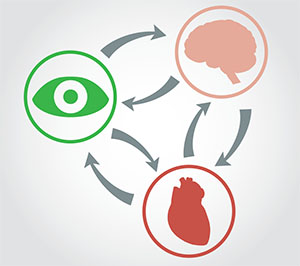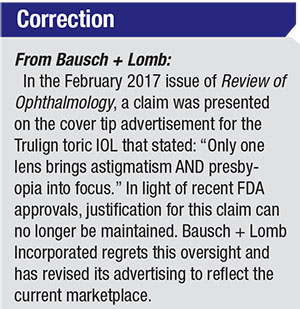Alirocumab is a member of a new class of monoclonal antibody drugs called proprotein convertase subtilisin/kexin type 9 inhibitors, or PCSK9 inhibitors. They’re designed for patients with high cholesterol that’s uncontrolled by conventional statin therapy or who can’t tolerate a statin. Some of these patients have hereditary conditions that cause extremely high cholesterol. When added to a statin in these patients, a PCSK9 inhibitor can lower a patient’s cholesterol by as much as 60 percent.1
In the study, researchers pooled the data from 14 trials (double-blind treatment for eight to 14 weeks; n: 3,340 alirocumab; 1,894 controls [placebo or the cholesterol drug ezetimibe]). They found similar rates of adverse events in patients with an LDL less than 25 and those with LDL less than 15. However, in a propensity score analysis, patients with LDL less than 25 had a higher rate of cataracts (2.6 percent) than those with a cholesterol score of 25 or greater (0.8 percent; hazard ratio: 3.4; 95 percent confidence interval: 1.58 to 7.35).2
Lead author Jennifer Robinson, MD, MPH, is a professor in the epidemiology department at the University of Iowa College of Public Health and director of the college’s Preventive Intervention Center. She says the cataract results are puzzling. “It was reassuring that, in one sense, the PCSK9 inhibitor didn’t have an effect on other bodily functions, but we did note that those patients with very low LDL did have a higher rate of cataracts or cataract surgery,” she says. “We don’t know if it was caused by the PCSK9 drug or because the people that ended up with very low LDL levels on the PCSK9 inhibitor started with lower LDL levels, had diabetes, were older, had cardiovascular disease, were male or had some other risk factor for cataracts. What it does tell us is that it’s a potential side effect. We looked at other studies, and noted cataract in one statin study where the patients got low LDLs, but we didn’t find it in a different study in which patients also had low LDL after treatment. So, we really don’t know.”
In the study, Dr. Robinson and her co-authors postulate some possible mechanisms behind the finding. They note that cholesterol that’s needed by the crystalline lens is synthesized in situ and that, in animal toxicity studies, high doses of statins have been shown to inhibit lens cholesterol biosynthesis and promote cataract formation, but this result hasn’t been reproduced in human studies.2 They go on to say that studies have shown an increased rate of cataract after statin treatment, and that cataract has also been associated with hyperglycemia and blood pressure levels. “It could be that acute LDL-C lowering accelerates underlying aging or metabolic syndrome or diabetes-related changes, contributing to cataracts,” they write.2
 |
She adds that, in the long run, even if cataract winds up being a proven side effect of these drugs, physicians and patients may need to weigh the risks vs. the benefits of the new therapies. “The reason we’re lowering bad cholesterol is to prevent heart attacks and strokes,” she says. “So, at the end of the day, you have to weigh that with the adverse events. If we find a dramatic reduction in heart attack and stroke in these large trials, we have to take that into consideration. Not to minimize cataracts, but in the grand scheme of things, they aren’t as bad as dying from a stroke.”
There’s also the question of the study’s adverse event findings’ clinical relevance in the real world, in light of the kinds of patients who will be taking these drugs. “One group of patients who will be candidates are those with genetic high cholesterol, and having a low LDL isn’t the problem with them because they’re starting at levels of 300 or 400,” Dr. Robinson says. “Where it will be an issue is if, on the basis of these ongoing trials, we find that people with heart disease benefit from these drugs. In that case, we’re probably going to have to be a little more careful about who we select to receive them, because they’re quite expensive—around $15,000 per year. They’re not for everyone, though the very high-risk people whose cholesterol is high on a statin would probably be reasonable candidates. If that’s the case, then, getting low LDLs isn’t a consideration anymore, so cataract may not be a clinical issue for these patients.”
Another possible finding might be that, similar to patients who take statins and wind up getting diabetes, these new cholesterol-lowering drugs may just be speeding up the inevitable. “A lot of people who develop diabetes while on a statin would be at risk for diabetes anyway even if they weren’t on a statin,” Dr. Robinson says. “As it happens, there’s a small excess risk for diabetes in statin-treated patients vs. people who don’t get statins. It turns out that all we do is nudge them into diabetes a couple of months earlier because they had diabetes risk factors and were going to get it anyway. So, in the case of cataract and low LDL levels and/or PCSK9 inhibitors, these factors may be tipping people a little earlier into cataract who would have developed cataracts anyway. That’s speculation, and we don’t have data to support that, but I don’t think we’re causing cataracts in totally normal lenses.”
1. Seidah NG. Proprotein convertase subtilisin kexin 9 (PCSK9) inhibitors in the treatment of hypercholesterolemia and other pathologies. Curr Pharm Des 2013;19:17:3161-72.
2. Robinson JG, Rosenson RS, Farnier M, et al. Safety of very low low-density lipoprotein cholesterol levels with alirocumab: Pooled data from randomized trials. J Amer Coll Cardiol 2017;69:5:471-482.
The Hazards of Detergent Pods to Children
With the widespread use of detergent pods, more and more children are admitted to the emergency room with ocular burns. In the span of three years, the instances of admission spiked from just 12 reported cases to 1,201.1 In hopes of understanding this spike in ocular burns in children, researchers at the Johns Hopkins Center for Injury Research and Policy released a study documenting the supposed causes of these injuries.
Researchers consulted the National Electronic Injury Surveillance System, focusing specifically on children aged 3 to 4 years (i.e., preschool-aged children) reasoning that children younger than 3 wouldn’t usually be strong enough to damage a detergent pod. They used the NEISS to search for narrative summaries that referenced the laundry detergent pods, looking specifically at the year, sex, race/ethnicity, setting and the circumstances leading to the injuries.
Based on data from the NEISS, between January 1, 2010 and December 31, 2015, 1,201 laundry detergent pod-related ocular burns occurred among children ages 3 to 4. The proportion of all chemical ocular injuries associated with these devices increased from 0.8 percent of burns in 2012 to 26 percent in 2015.1 All patients were treated and released from the emergency department. Patients were mostly white (46.3 percent) and non-Hispanic (88.7 percent).1
Sterling Haring, DO, MPH, the author of the study, comments on the cause of this spike in ocular burns. “I think it’s really two things,” he says. “First we’re seeing increased market penetration of the pods. They’re cheaper, so people are buying them and keeping them in their home more. They’re more common. Number two, I think, is that they have been in homes longer. Within the first month that a person goes out and buys these, they probably keep their kids away from them because they aren’t as comfortable with them. As people handle and use them more, they get more comfortable with them and don’t see them the same way they would bleach.”
Dr. Haring, however, provides some preventative advice to hopefully reverse the increasing instances of burns. “There have been a lot of reports on different types of poisoning associated with these things, so it’s pretty clear they’re not the safest of objects, but if you’re going to have them in your house, keep them up, away and out of sight. That’s the best advice. Anyone with kids knows that if kids see it, they can get to it,” he says. “Number two is, if you see your kid playing with one, take it away. It may look safe, but it’s not. Obviously the key point here is to make sure you wash your child’s eyes if they exposed themselves to these pods, and don’t hesitate to call 911.”
1. Haring S, Sheffield I, Frattaroli S. Detergent pod-related eye injuries among preschool-aged children. JAMA Ophthalmol; Published online February 2, 2017.
Stanford Awarded Vision Grant
 |
In a statement issued by the University, Jeffrey Goldberg, MD, PhD, professor and chair of ophthalmology, says plans are already under way for making use of the funds. “I couldn’t be more pleased to engage the support of RPB and their outstanding scientists and advisers,” Dr. Goldberg says. “We are planning to support projects that leverage collaborations between scientists in the Department of Ophthalmology and across the breadth of Stanford’s campus.”
Potential projects in the works include an investigation of brain stimulation to boost vision in patients with retinal or optic-nerve degeneration, and work to identify molecular pathways to cue a retina to self-repair when damaged by disease, Goldberg says. REVIEW



